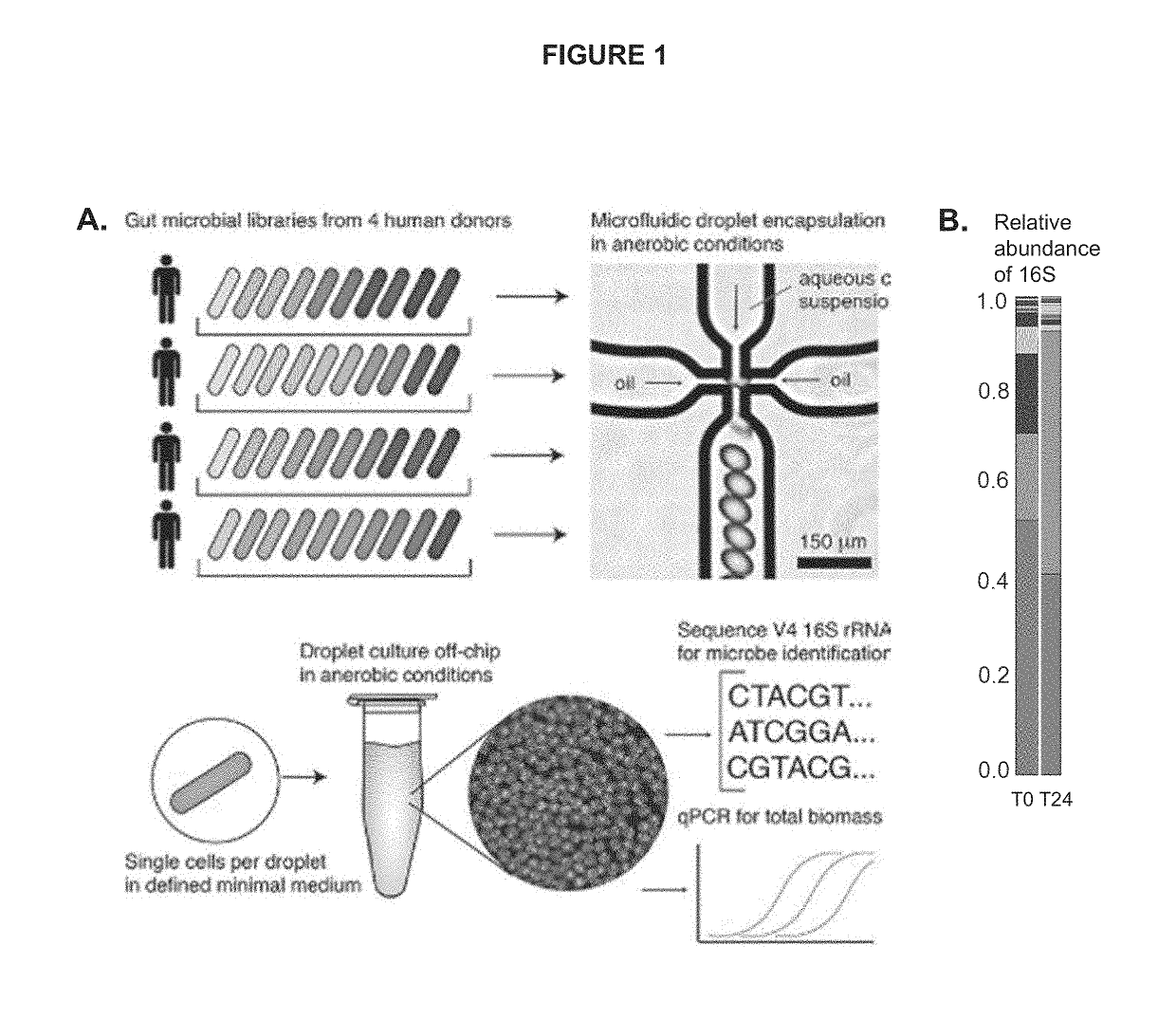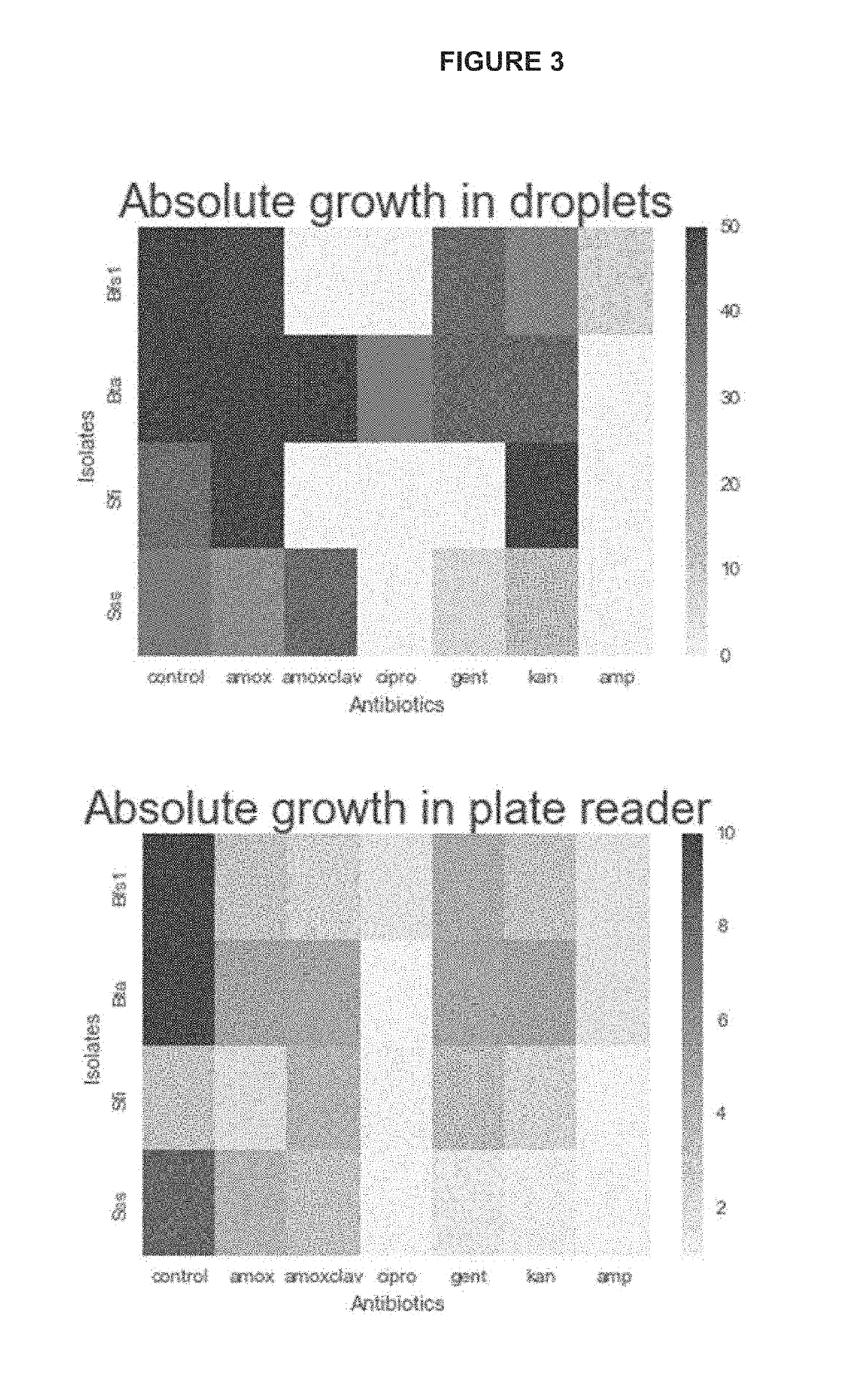Rapid phenotyping and identification of microbes from a complex microbial community
a complex microbial community and rapid phenotyping technology, applied in the field of microbiology, ecology, microfluidics, can solve the problems of affecting the clinical outcome of patients, etc., to achieve efficient measurement of growth rate, high-throughput, and cost-effective
- Summary
- Abstract
- Description
- Claims
- Application Information
AI Technical Summary
Benefits of technology
Problems solved by technology
Method used
Image
Examples
example 1
rocedure
[0089](A) Droplets were made on a microfluidic chip (6-junction droplet chip, Dolomite Microfluidics). Bacterial media varied by assay; for the oil phase, fluorinated oil and surfactant mixture 1% Picosurf (SPHERE FLUIDICS®) in Novec 7500 (3M®) was used. One day prior to performing the droplet assay, all reagents including carrier oil, culture media, and carbon solutions were equilibrated to the anaerobic atmosphere in an anaerobic chamber (COY®). The fecal inoculum optical density at 600 nm was recorded and diluted according to the Poisson distribution:
P(n,n_)=n_ne-n_n!,
where n is the droplet occupancy (i.e. 0, 1, 2, . . . cells / droplet) and n, is the average number of cells per droplet given by: n=ρV, where V is droplet volume and ρ is cell density. Assays were performed at a n of 0.1-0.3 to minimize the number of droplets loaded with more than one cell. Thus, for a fixed droplet volume and n, the target cell concentration can be obtained from:
ρ=Kn_V,
where K is a constant ...
example 2
of Bacteria in Individual Droplets and Determining Absolute Growth Using Endpoint Measurements
[0092](A) Human stool samples were obtained and used to isolate individual bacterium within the human gut: Escherichia coli, Streptococcus agalactiae, Enterococcus faecalis, Enterobacter cloacae, Staphylococcus haemolyticus. These five facultative anaerobic bacteria were then encapsulated in aqueous droplets using a 6-junction droplet chip (DOLOMITE® microfluidics). The droplet chip produces aqueous droplets of a chosen growth media (such as Brain Heart Infusion (BHI) medium used in this example), which is surrounded by an oil-phase (fluoro-carbon oil, BIORAD®). The droplets were incubated in growth media at 37° C., under aerobic conditions for ˜12 hours. After incubation, the droplets demonstrated five distinct bacterial morphologies within droplets labelled A-E. (FIG. 9). These results also demonstrate the ability to isolate bacteria from a mixed community into individual droplets. (FIG. ...
example 3
Grown in Droplets Recapitulate Total Growth of Gut-Isolated Bacteria Compared with a Plate Reader
[0094]To assess the ability to accurately measure the growth of bacteria isolated from a mixed community, bacteria isolated from the gut were grown in both a plate reader and droplets. To generate droplet cultures, nine individual isolates of bacteria from the human gut were grown in culture overnight in Gifu Anaerobic media with the addition of vitamin K and Hemin (modified Gifu Anaerobic media; mGAM). Cultures were grown anaerobically at 37° C. The nine cultures were then mixed together and diluted to isolate only one bacterium per droplet. The mixed culture had an OD600 of 0.66, and 8.7 μl of the mixed culture was added to 4 mL of mGAM medium. Droplets were generated using a 6-junction droplet chip (DOLOMITE® microfluidics), flowing mGAM medium through the oil (fluoro-carbon oil, BIORAD®). Droplets were sampled at the time of generating the droplets (T0), and the remaining droplets we...
PUM
| Property | Measurement | Unit |
|---|---|---|
| diameter | aaaaa | aaaaa |
| diameter | aaaaa | aaaaa |
| diameter | aaaaa | aaaaa |
Abstract
Description
Claims
Application Information
 Login to View More
Login to View More - R&D
- Intellectual Property
- Life Sciences
- Materials
- Tech Scout
- Unparalleled Data Quality
- Higher Quality Content
- 60% Fewer Hallucinations
Browse by: Latest US Patents, China's latest patents, Technical Efficacy Thesaurus, Application Domain, Technology Topic, Popular Technical Reports.
© 2025 PatSnap. All rights reserved.Legal|Privacy policy|Modern Slavery Act Transparency Statement|Sitemap|About US| Contact US: help@patsnap.com



